
Photo designed by Gladys Wood for Jill Malone's CIS 246 - Digital Imaging, Fall 1998 at Mira Costa College in Oceanside, CA.
Joseph Albert BagnallBiographical Sketch |
| Born: |
January 15, 1930 at Hughes Memorial Hospital, Spanish fork, Utah |
| 1930 |
Contracted polio at age two and lost the use of my right leg for about six months. No residuals.
My parents tell of a miracle faith healing as a result of a prayer circle ritual in the Mormon
Temple in Manti, Utah.
|
| 1932 |
Lived on family ranch in Chester, Utah, each summer, and in Moroni, Utah, in winter. |
| 1936 |
Started Lincoln Elementary School in Moroni, Utah. Played clarinet in band in 3rd grade. |
| 1940 |
Father became Superintendent of Schools of North Sanpete School District. The family
moved to Mt. Pleasant, Utah, where I attended Hamilton Elementary School for 4th, 5th,
and 6th grades. |
| 1942 |
Attended North Sanpete Junior High School in Mt. Pleasant , Utah, where I enjoyed playing
on the basketball team. Served as Student Body President of NSJH in my Freshman year. |
| 1944 |
Attended North Sanpete High School for my Sophomore and Junior years. Served as
a cheer leader and Prom Master. Enjoyed drama, chorus and band. Average Student. |
| 1947 |
Attended South High School in Salt Lake City. Served as Sports Editor on the South
High Scribe. Won the Outstanding Cadet Award in South High ROTC, September, 1947.
Sang in a fabulous 211 voice Acapella Choir at South. Choir sang in the Rose Bowl.
|

Joseph A. Bagnall
Class of 1948
South High School
|
Three Members of the Staff of The Daily Utah Chronicle,
The Student Newspaper at the University of Utah, 1949
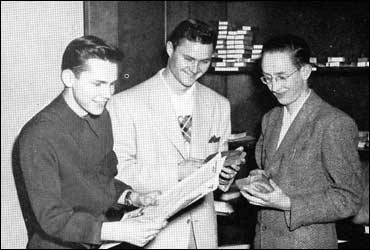
Left to Right: Joe Bagnall, Bob Muir, and Clint Barber
|
| 1949 |
Attended University of Utah. Sports Editor on the Daily Utah Chronicle, the college
daily. Wrote the article for the retiring of the jersey of All American basketball star,Vern
Gardner. |

Vern Gardner's No. 33 will be retired in the Utah sports hall of fame tomorrow at the annual song fest.
Only Ferrin's No. 22 has received this distinction. Arnie's was honored last year.
Gardner's No. 33 retired tomorrow
By JOE BAGNALL
Another bright page of athletic history will be written into the
annals of Utah's sports glory when Vern Gardner's famous 33 will be
retired as a special feature on Thursday night's stadium songfest.
Thus Gardner joins the immortal Ute, Arnie Ferrin, whose number was retired
in a game against Wyoming at the fieldhouse last year. These Ute casaba greats
have warmed nets all over the nation to lead Utah's colors to basketball hall of fame.
Tribute has been paid big Vern this season as a nation of spectators heralded his play,
and jested the renaming of the Garden after the popular Ute
Aspiring to all-American selection for the third consecutive year, and to all-conference honors for
|
the fourth , the big fellow has won distinction as a prominent sports figure.
His first prestige came in 1947 when he was named the NIT's most valuable player.
Here he led Utah to the national championship.
Since the big Ute's first campaign as a frosh, his success has grown to climax in his representing
the west as one of a galaxy of collegiate all-stars in Madison Square Garden play in March. And as this Utah great concludes
his college career, he focuses attention on the offers from professional leagues. He reserves decision as yet, and possibly will
continue to do so until contract deadline.
In the Basketball Association of America league, Vern has been drafted by the Phillies, and is thus ineligible for another
team in the same pro-loop.
|
|
| 1949 |
Pledged to Pi Kappa Alpha fraternity. |

|
| 1950 |
Called to serve in the Central States Mission for the Mormon Church. Served in
Henryetta, Oklahoma and Independence, Missouri. While serving in Henryetta,
my companion and I visited a family in Seminole, Oklahoma. They had a state
of the art wire recorder, and they invited us to record a message to be sent
to our families in Utah. I recorded a message and sent it to my famiily
who had it transcribed to a 78 rpm vinyl record. Please click below to hear
a recording of an idealistic, young missionary, barely out of his teens.
Click to hear message
|
| 1951 |
Moved with my family to Perris, CA where my father served as Manager of the Southern
California LDS Welfare Ranch. I attended Riverside City College for one semester and
then moved to Los Angeles where I worked as an apprentice proof reader on the L.A.
Times. While working at the Times, I also attended Los Angeles City College. |
| 1953 |
Married Phyllis Luck. Worked at the Los Angeles Public Library and started my upper
division work at Cal State L.A. for my Bachelor's degree in Elementary Education. |
| 1955 |
Graduated with my B.A. in Elementary Education and a California teaching credential.
Was hired as a 5th grade teacher in the new La Rosa Elementary School in the Temple
City Unified School District. Taught in this school for three years and simultaneously
studied toward a Master's degree with a major in history and a minor in political science. I also worked on a California General Secondary Teaching Credential, and a Jr. College Teaching
Credential. |
| 1958 |
It was summertime and it was my good fortune to have served as President of the
Greater Arcadia Stevenson for President Club in 1956. Members of the past club
received invitations to a special reception to honor Senator John F. Kennedy at the
Biltmore Hotel in Los Angeles. Ostensibly the occasion was for Dore Schary, a Hollywood movie producer to present a plaque to the young Senator for narrating
the Democratic Party film for the 1956 convention. Title of the film was, "The Pursuit
Of Happiness." The real reason for the reception was (without a doubt) an attempt
by JFK and his handlers to explore a presidential run. About fifty prominent Democrats
including Governor Edmund G. (Pat) Brown, were in attendance.
I had a brief conversation with JFK, put my arm around his waist, and asked him to run
for the Presidency in 1960. He thanked me for my interest and support, but he said he wasn't considering it at that time. I signed his guest list and went away hoping he would run for president.
There was soon thereafter a nice letter and an autographed 8X10 photograph in my mailbox. He also sent Christmas cards for
the next two years. These are all mounted in a large handsome frame that is in my
study.
|
| 1959 |
Completed my Maters Degree at Cal State L.A., and earned my teaching credentials.
Began teaching at Monterey High School in Monterey, CA. Taught U.S. History,
Geography, Journalism, and was the advisor to THE GALLEON, the award winning,
weekly student newspaper. Simultaneously taught part time in the history department at
Monterey Peninsula College.
In the fall of 1959, David Matt, an English instructor, accompanied me and my Monterey
High student journalists to a high school journalism conference at Stanford University.
We traveled by bus and had a wonderful time.
Aware of the fact that Alexander Kerensky, (Prime Minister of the provisional
government of Russia in a brief period before the Communist revolution) was a
resident scholar at Stanford University's Library on War, Peace and Revolution, we
decided to try and get a brief interview with him.
It was Saturday morning. We obtained information about where Kerensky was living on
campus and knocked on his apartment door; he greeted us in robe and house slippers.
We identified ourselves as visiting journalists on campus and requested a brief interview with him. He graciously agreed and told us a few things about his escape from Russia disguised as a woman. Characterizing the Soviet regime as the most reactionary in the world, he predicted that it would fail. The meeting was about 20 minutes. An exciting
experience!
|
| 1960 |
It was Sunday evening in the Carmel Valley and I was grading student papers when the
telephone rang. I answered and a voice said, "Hello, this is Senator Kennedy." It turned out that he had called me to say that he and Jackie were resting at Pebble Beach for a
couple of days after an exhaustive Oregon primary. He wanted me to know that he was
not holding a press conference during his stay, but if he had planned one our Monterey High journalists would have been invited.
During this same year Eleanor Roosevelt and former Prime Minister Clement Atlee
were speakers in the Monterey Peninsula College evening lecture series. Monterey High Journalists accompanied me to press conferences granted by each of these
distinguished speakers. Linden Leavitt, the man who sponsored and hosted these events, was the Dean of the Evening division at Monterey Peninsula College. Linden
became my educational role model and inspired me toward my own career goals.
Inspired by Senator John F. Kennedy, I worked as a volunteer and walked a precinct
in Monterey, California, for him before the election of 1960.
|
| 1961 |
After two years on the Monterey Peninsula, I decided to return to Southern California
to study for my doctorate. Taking a position at Millikan High School in Long Beach, I spent the next three years studying part time in the evening at University of Southern
California. As I moved toward a doctorate in history at USC, I began applying for full
time work as a professor of history at the community college level
|
| 1964 |
I was hired as a full time professor of history at Fullerton College. At Fullerton I also served as the foreign student adviser. It was a privilege to work with students from various countries of the world. |

The Bagnall Family This picture was taken in 1964, our first year at Fullerton College.
Phyllis became President of faculty wives (400 member faculty) and I served as the Faculty representative in Faculty
Association of California Community Colleges. L to R top: Pamela and Nancy Jo, Middle: Phyllis and Joseph A.,
Bottom: Melanie and Joseph M.
|
| 1968 |
On April 22, 1968, the foreign students sponsored their first International Day on
the Fullerton campus. Foreign student organizations from nine other campuses attended, as well as the general public. The following were events of the day:
A full length movie on the life of Albert Schweitzer
.
A karate demonstration
A Radio Telesymposium This was a communications coup. Radio talk show host Joel Spivak brought his three hour KLAC radio program to campus. He sat on stage in the campus theatre with a foreign student panel and myself. We, in turn, were hooked, via telephone, with Senator Robert F. Kennedy of New York, Senator
Thomas Kuchel of California, and Senator John Tower of Texas. Questions were posed by the panel to the senators on two topics, Red China and Vietnam. The questioners also included students who lined up and participated, on air, with
microphones placed in the aisles, and people who called in from the vast Southern
California radio audience.
A dance in the Fullerton College Student Center featuring the Disney Hotel
Orchestra was the final event of the day..
It was my privilege to plan, direct, and help students implement this eventful day.
The news story in the Fullerton College Hornet newspaper follows:
|
|
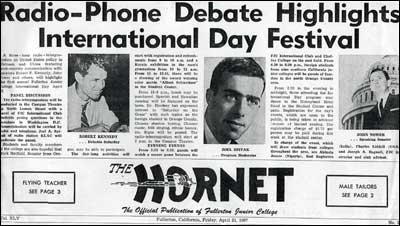
Click Here to Enlarge
|
| 1967-68 |
New career goals motivated me to drop the program for a Ph.D. in history at
USC in favor of an Ed.D. at UCLA. My project for the doctoral program was
the founding of a student organization called the Center for the Study of the Future of
Man at Fullerton College.
|
| 1969 |
The Center for the Study of the Future of Man soon grew to a membership of over
500 students. This organization was designed to involve a large segment of our
student population in political projects that emphasized gradualism, reform, and long term
goals. In 1969 it was important to turn students' minds away from campus violence,
destruction of school property, seizure of various president's offices and direct action
of all kinds against the Vietnam war.
The Center was dedicated by Norman Cousins, distinguished editor of Saturday
Review. He was the first speaker in a public forum that included Secretary of
the Interior Stewart Udall on the environment, Richard Buffum, columnist on the Los
Angeles Times, Frank K. Kelly, Vice President of the Center for the Study of Democratic Institutions,
and Dr. John Casey, President of Fullerton College.
The Center developed a special section in our college library with materials on
environmental and thermonuclear issues.
Richard Buffum wrote three laudatory columns about the Center
in the Los Angeles Times and there was also a feature article in the Times on our work.
|
| 1970 |
Hired by the Santa Barbara City College Continuing Education Division as a
coordinator, in one year I advanced to the position of Assistant Dean.
In my twelve years as an administrator at SBCC, I was directly responsible for the following areas of supervision: World, National, and Local Affairs, Philosophy and Humanities, Science, Music, ESL, Basic Education, Adult Evening High School,
Buildings and Grounds, and the Student Body Account.
I also developed lecture series featuring the following speakers:
Robert Hutchins, Senator Wayne Morse, Dr. Jack Peltason, and others on the
topic, "Do We Need a New U. S. Constitution?"
Dr. Edward Teller, Amory Lovins, Secretary of Interior Stewart Udall, Roger Billings, and others on alternative fuels.
Attorney General Ramsey Clark and Congressman Barry Goldwater on the Bicentennial of the American Revolution.
Ruth Carter Stapleton (sister of President Carter) on the power of love.
Psychiatrist Ian Stevenson on the possibility of reincarnation.
Editor Norman Cousins on American foreign policy.
George McGovern, Robert F. Kennedy, Jr. and many, many others.
In the field of music I started the Santa Barbara City College Night Jazz Band and scheduled
a concert with Ann Richards, (Mrs. Stan Kenton) a vocalist with the Stan Kenton band. I also brought many Kenton alumni to Santa Barbara for special concerts including Buddy Childers, trumpeter, and the Shelley Manne Trio.
Three other special jazz concerts featured the Cal State Northridge and the Cal State Los Angeles
jazz ensembles and the wonderful L.A. Jazz Choir from Pierce College.
A special class in opera was offered as well.
As an administrator at SBCC, I also supervised between 80-95 instructors, depending on the
the number of classes offered in the period 1970-1982.
|
| 1973 |
Received Ed.D. degree from UCLA
Co-authored United States History: the Relevant Issues, Dubuque: William C. Brown.
This book was adopted in 32 colleges and universities.
|
| 1982 |
Married Naomi Blasjo, who upon graduation recieved the Outstanding Woman Student award at City College, and retired from Santa Barbara City College and the California
educational system. Naomi and I lived on the family ranch in Chester, Utah, and later in Salt Lake City.
Wrote and produced a television documentary titled, John F. Kennedy's Lost Pathway
To Peace. This 30 minute program was narrated by Robert Vaughn. It played as a short subject (for one week) at the Monica Fourplex theatre in Santa Monica, and it aired on Ted Turner's SuperStation (TBS) on the 70th anniversary of JFK's birth. It also aired on KCET Los Angeles, and a number of other PBS affiliates, and on University of California San Diego Television (UCSDTV).
|

Joseph A. and Naomi C. July 17, 1982
|
| 1984 |
On December 10, 1984, Ashley Jo Bagnall was born. |
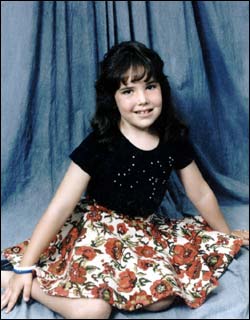
Ashley Jo Bagnall Age 8
|
| 1985 |
Moved from Utah back to Southern California. Worked as an adjunct history professor
At MiraCosta College from 1985 to 2003, and as an adjunct history professor at
Palomar College from 1996 to the present. Also worked at Army Navy Academy in
Carlsbad, California from 1985 to 1996, where I was Department Chairman in Social Studies. I started the annual trip to Harvard Model Congress where Honor Cadets participated with about 600 other students in a mock congress. We won awards each year in this splendid, week long laboratory of American politics. Army Navy Academy was
the only California school to participate in this great annual event.
|
| 1992 |
Published President John Fitgerald's Grand and Global Alliance: World Order for the New
Century. Lanham, Maryland: University Press of America. This book was published in
Commemoration of the 75th anniversary of the birth of President Kennedy in the United Nations'
Decade of International Law, 1990-1999. I was interviewed by Charles Osgood
on the 75th anniversary of JFK's birth on the "Osgood File" (CBS Radio Network).
Click to hear the Osgood message
|
| 1997 |
Published The Politics of Survival: Resolving the Seven Deadly Trends. McGraw Hill.
The seven deadly trends outlined in this book were/are: ozone depletion, acid rain, global warming, destruction of rain forests, nuclear proliferation, the population explosion, and apathy. World Federalism is needed for the resolution of these trends.
|
| 2002 |
Published The Kennedy Option: Pursuit of World Law. University Press of America. |
| 2003 |
Ashley Jo Bagnall is engaged to Benjamin Davis |
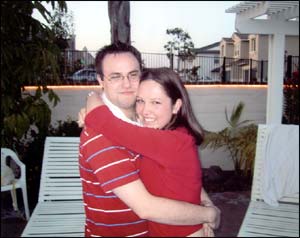
Ben and Ashley Jo
|
CURRICULUM VITA 1982
This is a summary of my service in public education up to the time that
I retired as a full time employee. Since that time I have spent eleven years
in full time work at Army Navy Academy, a private institution, and, as of
fall 2003. eighteen years in part time employment (usually a 60% assignment)
at National University, Park University, MiraCosta and Palomar Colleges.

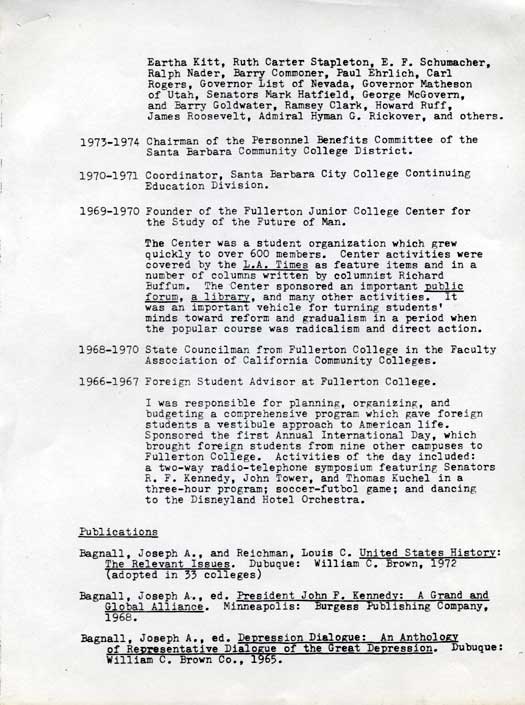
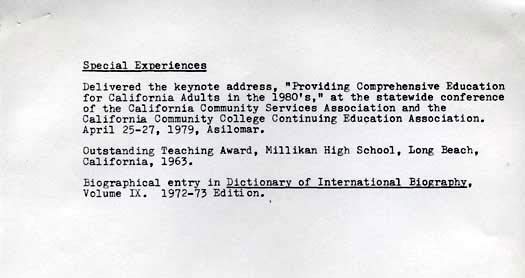
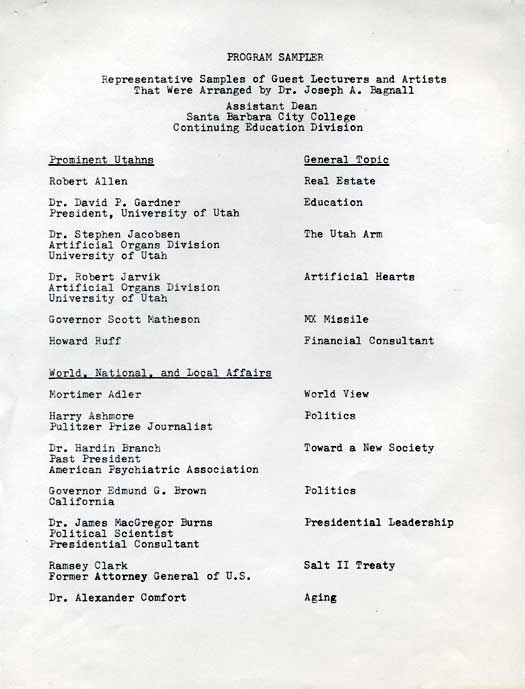

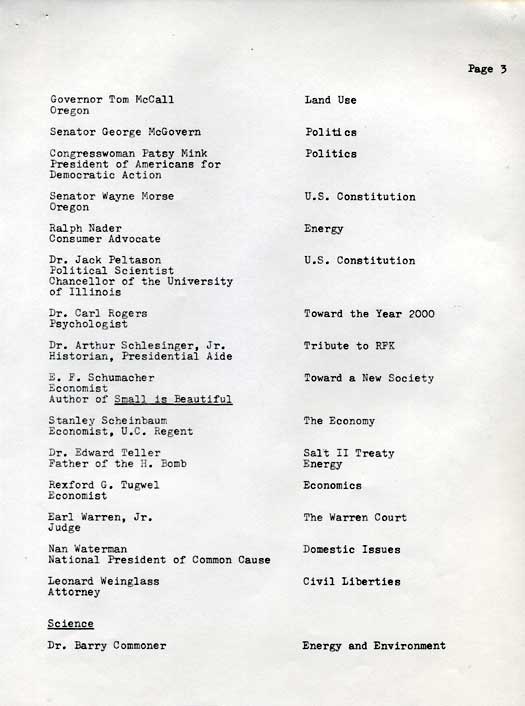

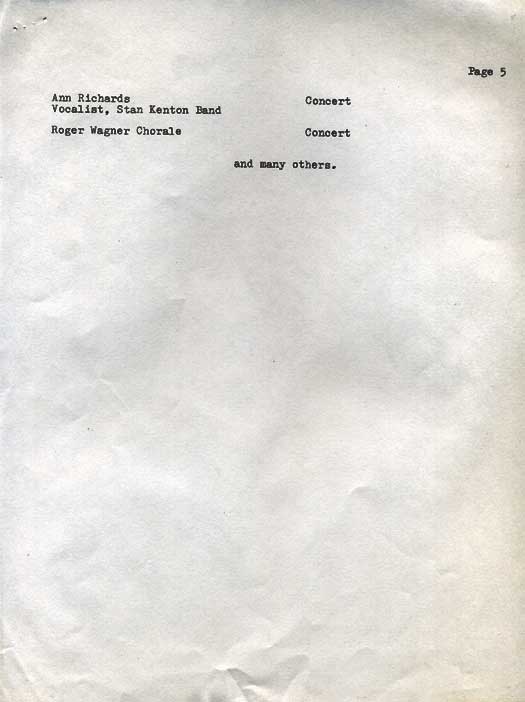
|
Back to Homepage

|

